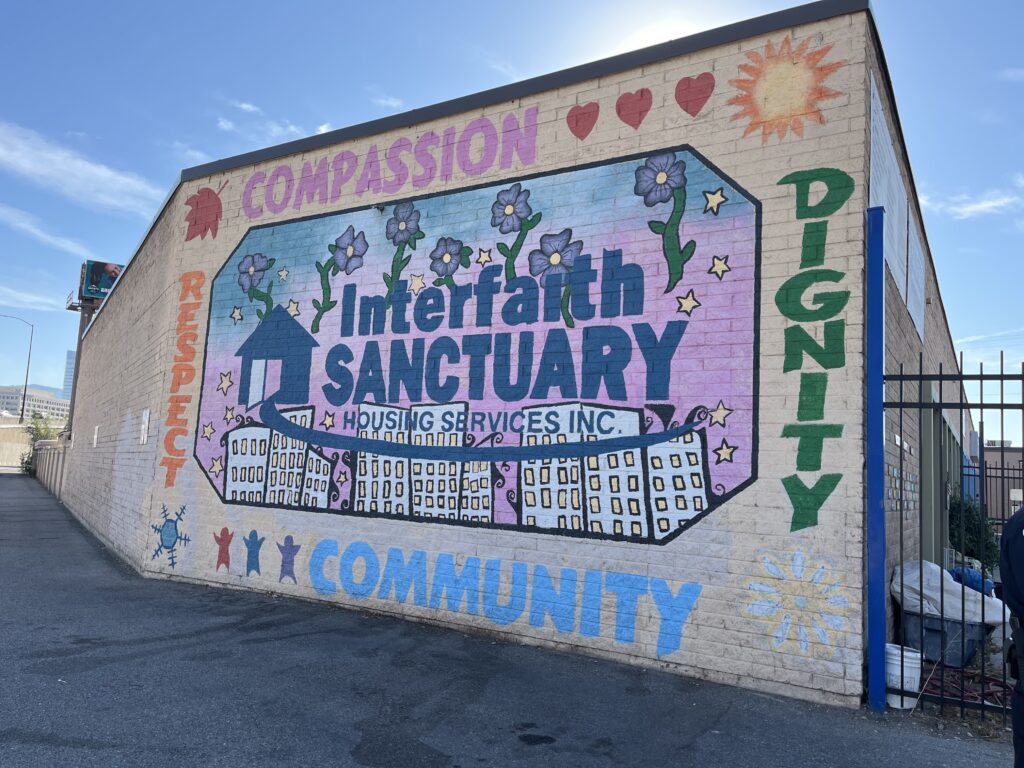By Molly Balison

A middle-aged Ukrainian woman named Lydia wakes up in a park shivering. She brushes fallen leaves off her well-loved sleeping bag before rolling it up. She’s already dressed for the day in a long sleeve two sizes too big and loose fitting jeans with a blanket as a make-shift coat. Her trustee piece of cardboard that reads “anything helps” in black ink nestles in the layers of her portable bed as she makes her way toward the nearest superstore to see if she can get some spare cash to buy a meal.
Lydia is one of the individuals that faith leaders set out to help when they responded to the homelessness crisis in Boise. In 2005, the U.S. Department of Housing and Urban Development’s point-in-time count collected by Idaho’s Continuums of Care recorded 5,424 unhoused individuals across the state, 3,814 of which were in emergency shelters. In 2024, 2,750 total homeless individuals were counted in Idaho showing nearly a 50% decrease over two decades.
These aren’t just numbers — they’re humans with stories, like Lydia. Stories that led to the founding of Interfaith Sanctuary.
Twenty years ago, the shelter Community House closed, and many people resorted to the streets and lives were lost to freezing nights. That’s when 35-40 people of all faiths came together to address the crisis of the growing homeless population. The Community house closure devastated people Within two weeks of their meeting, a plan was formed to open the doors of different faith buildings to provide safe shelter as quickly as possible. For the first year the shelter rotated between various locations during the coldest months of the year and was operated solely by congregations of volunteers. The second year, Nick Guho with Guhuo Corp. donated a facility on Jefferson street to consolidate the efforts of the shelter.
In 2007, enough funding was raised to purchase the warehouse at 1620 W. River St., which remains the current location of Interfaith Sanctuary. That November the Interfaith Sanctuary emergency shelter officially opened its doors.
The name “Interfaith” comes from the unification of different faiths with one common goal: to provide shelter and stability for Boise’s most vulnerable population. The shelter’s mission statement is, “Interfaith Sanctuary Shelter is home for a warm meal and a safe place to lay your head for all genders, races, religions, and sexual orientation. We are a sanctuary for families with children allowing them to find shelter together. We are a shelter full of hopes and dreams offering second chances and supportive services everyday.”
Some of the founders include: Boise Baha’i Temple; Boise First Congregational United Church of Christ; Boise First Presbyterian Church; Boise First United Methodist Church/Cathedral of the Rockies; Boise Friends; Boise Unitarian Universalist Fellowship; Congregation Ahavath Beth Israel; Hari Krishna Temple and the Gupta Family; Hillview United Methodist Church; Humanists of Idaho; St. John’s Cathedral; St. Paul’s Baptist Church; St. Stephen’s Episcopal Church; The Interfaith Alliance of Idaho (board and members); Islamic Center of Boise; Treasure Valley Metropolitan Community Church (now Liberating Spirit MCC); Carnegie Library; Boise State University Department of Social Work faculty and students; Catholic Charities of Idaho; Idaho Food Bank; St. Luke’s Regional Medical Center; The LGBTQ Community Center.
For its first ten years of operation, Interfaith Sanctuary opened at 5 p.m. every night and provided a warm meal and a bed. Guests were expected to leave at 7 a.m. the next morning. As the only low barrier shelter in Boise, the facility has minimal admittance requirements to allow families to stay together and help people in need no matter their circumstances.
Ed Keener, one of the founders and the current Board President of Interfaith Sanctuary said, “We’ve always believed that we could be a low barrier shelter and be successful. We could deal with multiple problems that people had.”
There was no programming or case management until the current Executive Director, Jodi Peterson-Stigers became part of the team in 2015. She spent time with the people who resided in “tent city” in the alley behind the shelter, Cooper Court, before it was cleared out by Boise Police in December 2015.
“When I started learning more about what homelessness really is, I started seeing these homeless people much differently,” Peterson-Stigers said. “I started to see a group of people who were so fragile and sick and they didn’t have any support. They didn’t have a place to call home. They didn’t have a support system, they didn’t have health care or a place to call home, somewhere to go and get better.”
The shelter and programming that exists today has seen a tumultuous history, but the stories that this sanctuary was founded on motivates the organization to face whatever battles are necessary to protect and serve Boise’s homeless.
“How grateful I am that there are people in this town that want, in a really significant way, to support a shelter that welcomes all people that has innovative programming and that stands for dignity, compassion, love, and respect,” Keener said.
A mural large enough to be visible to drivers on the overpass spans the back of the shelter. The words “respect”, “compassion”, “dignity” and “community” are visible enough for drivers passing on the freeway to catch a glimpse of. These are values that Interfaith Sanctuary was built on and encourages their guests, staff and neighbors to live by.
“ Those values are all about being a neighbor and counting each person as a unique individual that’s worthy love and compassion and whatever we can provide that would help them on their journey,” Keener said.
